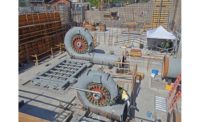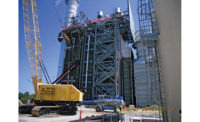Birdsboro Power Plant
Birdsboro, Pa.
Best Project
Owner: Birdsboro Power LLC
EPC Contractor/Lead Design Firm: Kiewit
OEM: General Electric
Owner’s Engineer: HDR
Subcontractors: B. Pietrini & Sons Inc. (Concrete); LB Construction Enterprises (Rebar); Environmental & Infrastructure Group (Environmental Remediation); Continental Fire Sprinkler Co.; The Warko Group (Sewer/Mechanical); Frasier Electric
Completed in June after nearly three years of construction, the high-efficiency, 485-MW natural gas-fired plant provides much needed energy for the region and is a springboard for future economic development. To deliver the state-of-the-art facility, the project team first had to overcome many vestiges of the 90-acre site’s past. Once occupied by a steel foundry and idled for more than 30 years, the site was rife with decaying buildings and multiple contaminants that posed potential health and environmental risks. The project “transformed a barren site to something the community is happy about,” says one judge.
During an extensive site remediation effort, the discovery of undocumented deep vaults and foundations challenged the team to quickly redesign the site preparation plan without compromising other facets of the project’s critical path. Ultimately, all underground structures and obstructions were removed, followed by over-excavation and backfill.
The challenges didn’t end with creating a more suitable site for construction. Configuring a tie-in to a major gas transmission line required navigating a difficult equipment layout while making provisions for future maintenance access. The team carefully planned and coordinated installing advanced, heavy-duty gas and steam turbine equipment in a single-shaft configuration, a first-of-its-kind arrangement for the major components, the team says.
Given the plant’s location adjacent to the town of Birdsboro, noise attenuation requirements were particularly critical. Consultation with industrial noise experts yielded a design that meets strict specifications to mute facility operations to the fullest extent possible. Additional mitigation measures include a noise wall installed alongside the pipe rack, extensive use of noise insulation material in the turbine building and low-noise baffles on the cooling tower to minimize the sound of falling water.
Throughout the project, contractor field superintendents and engineers were required to self-inspect their work to make certain it was installed according to drawings and specifications. Engagement of union-trained craftworkers was essential to ensure the project was completed to the highest standards of quality and safety. Before any direct-hire craft arrived, the project’s civil contractor launched a Craft Voice in Safety (CVIS) team, in which craftworkers were selected to be on a committee of peers to address project-wide safety issues. CVIS members also joined superintendents and foremen to lead an Operational Summit to train staff and craft on topics such as safety, quality, operations and leadership skills.
Other safety activities included craft-led “safety rodeos” that provided valuable hands-on demonstrations to the entire team. A special Family Day event enabled workers to proudly demonstrate their work to family members and their peers. As a result of these and other efforts, the power plant experienced an OSHA recordable incident rate of 0.14 during nearly 1.4 million worker hours. Despite the intricate project requirements and subsurface surprises, the plant finished ahead of schedule and under budget. In addition to having a hazardous, long-idled property revitalized, the community will also benefit from having a revenue-generating facility and improved local road and utility infrastructure.






Post a comment to this article
Report Abusive Comment